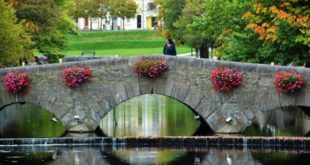As technologies advance and everyone is able to share their travels, a trend is emerging to discover little-visited corners of the planet.
This trend is leading to destinations such as Norway , Finland , Alaska or Iceland becoming more in demand for those photos of unexplored landscapes.
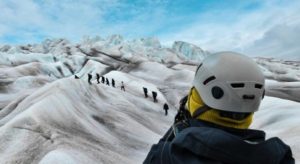
But there is a very little visited area, which belongs politically to Europe , but geographically to America , which still manages to maintain an almost virgin state, what we do not know is how long.
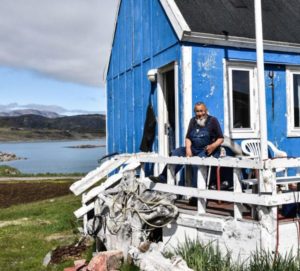
It is the land of the Eskimos or Inuit , which is how they are really known, since Eskimo is a derogatory word that means raw meat eater .
The original name of Greenland in the Inuit language is kalaallit nunaat, which means land of people .
Where is Greenland? Is not it a country?
When looking for Greenland on the map, we find it in the Arctic regions of Canada , in the northernmost part of the American continent, but in reality it is an autonomous region that administratively belongs to Denmark .
Despite being part of another country, Greenland has a certain degree of self-government, but it is absolutely dependent on Denmark since the Nordic state helps the Greenlanders economically.
Without this help, many of the only 57,000 inhabitants of this island could not survive the harsh winters.
Greenland is a country that for most of the year lives frozen and barely hours of sunlight.
But in summer everything changes, there is light all day and the coasts are thawed, revealing the impressive fjords full of icebergs that come off the glacier.
It is an island that is not as close to the North Pole as it may seem, at least the area most visited by tourists, which is the southern area.
Cities like Narsaq or even Nuuk are slightly above Scotland and close to Norway, Sweden and Finland.
Very interesting data from Greenland
Here you have some amazing data from Greenland

After Australia, it is the second largest island in the world , in which almost 80 percent of its surface is a huge glacier thousands of kilometers long.
If you cross the country by plane, it is the best way to see how impressive it is.
The glacier is so large that it has the second largest water reserve in the world.
The ice has a depth in some points of almost 3,000 meters. what causes that there are zones of the glacier that weigh so much that they sink the ground until being about 300 meters below the level of the sea.
The populations in Greenland are concentrated in the coastal areas, which, as we have said, melt in summer.
During the Second World War, the Americans used Greenland as an air base, which is why most of the current runways and buildings near the airports were built by them.
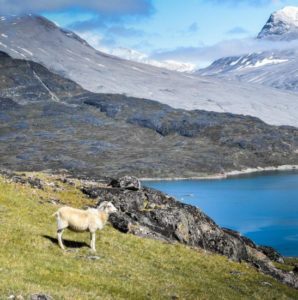
In fact, next to the Qasiurssaq airport is one of the famous waste cemeteries left by the Americans after leaving Greenland.
What animals are in Greenland?
As for the animals, most mammals have been introduced, such as sheep and cows, and in the wild there are only polar bears, caribou and arctic foxes.
There are no amphibians, not many of the insects that are usually found in many parts of the world, such as ants .
That if there are enough mosquitoes of a large, especially when the sun and no wind.
On its shores you can see especially seals, but there are many species of whales and dolphins passing near the island, so there are areas of Greenland where classical activity of tourists is whale watching .
As for birds, you can spot many eagles and gulls, as well as many species of smaller birds.
And for those who want to know if there are penguins, (many have asked me) the answer is no; there are only penguins in the Antarctic in the southern hemisphere.
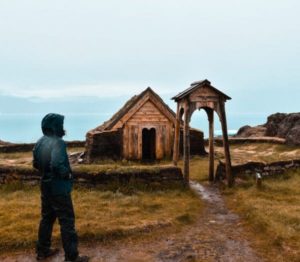
History of Greenland
Greenland is a region so little explored, that you do not really have too many historical records of it.
The only information that could be verified by the historians about Greenland , was in two sagas of stories transmitted orally, in the style of Los Cantares del Mio Cid.
Both, the Saga of Eric the Red , and the Saga of the Dutch , tell the same feats, Vikings who came to Iceland and continued west to conquer new lands.
Little by little they went through and colonized Greenland , until they reached Vinland , in present-day Newfoundland, near the border of Canada with the United States .
Many of these data have been verified by historical and anthropological studies, hence these sources are taken as valid.
The problem is that another part of the data could not be verified, which does not mean that they are not true; they simply could not be contrasted for lack of vestiges or initiatives and means to study them.
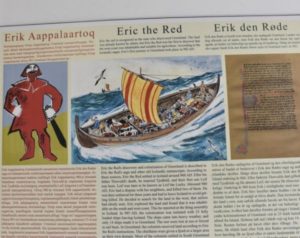
Today, after many studies of archaeological remains, it is known that here various Inuit Eskimo tribes passed sporadically for many centuries before disappearing and leaving the island uninhabited.
But if these sources are true, several centuries before Christopher Columbus arrived in America, the Vikings would have arrived in Greenland .
Who discovered Greenland?
The discovery of Greenland and the origin of the first documentations, was the result of one of the many stories of Vikings in which great sailors are mixed, with exile and murder.
The official account of the discovery of Greenland says Erick the Red was the first to arrive on the island, after being banished from Iceland, his native country, after a brawl in which he killed two people from his community.
It is said that both his father and he had very bad character.
This exile was granted especially since he and his father were considered great warriors and important people within the community, and as a deference to them, he was spared his life in exchange for exile for three years.
But it is said that Erick the Red sailed in that direction because he had already heard stories from other Viking navigators who had seen fertile and prosperous lands in those waters.
In any case, Erick arrives in 982 to the place of the current population of Narsaq in a single drakkar built with wood.
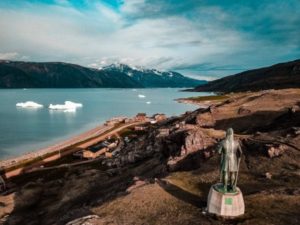
After studying the coasts, in principle they do not convince him too much, but he goes deeper inside the fjords until he reaches the town of Qassiarsuk .
This is where it would end up creating the first stable settlement in American territory of which there is evidence.
Right in this area where more Viking history was developed is where the Polar Lands central camp is located , the agency with which we made the trip, just 5 minutes by boat from Narsasuaq airport .
After three years of exile, Erick decides to return to Iceland to tell his exploits, and as a demand for his countrymen to join him, called this new land Greenland ( Greenland denomination in English).
It was a way to imply that they were very green and fertile lands and where you could prosper, as opposed to Iceland (Icelandic name in English), which means ice land , when in reality Iceland is much greener than Greenland.
Bear in mind that the Vikings were mainly farmers , who would end up introducing the sheep and pastures to feed them.
To travel to Greenland, he collected 24 drakkas, with about 750 people, of whom only 14 arrived.
Erick appropriates the fjord to such an extent that it gives it the name (E riksfjord , Erick’s fjord ) being the first Viking colony in Greenland with the intention of permanently establishing itself.
How long were the Vikings in Greenland?
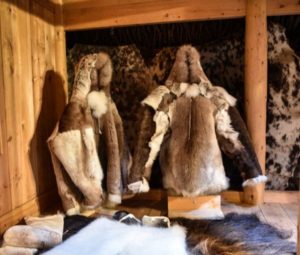
Although it seems incredible, the Vikings did not manage to survive in these lands for more than 400 years and in fact at the end of the 15th century they lost the references of what could happen to them. They just disappear.
Some sources say that it could be that they died with the black plague brought from Europe, or conflicts with the Inuit , who by those years already shared land with the Vikings or a small glaciation that occurred at that time.
And it is necessary to say that it is a region in which the conditions to get to survive in winter are really hard.
And if there was a decrease in temperatures, it could have been almost impossible to survive in those years.
Much of the difficulty of surviving in Greenland , also to this day, is the lack of resources beyond water and fish.
One very interesting thing about Greenland is that there are no trees and in fact they have a hard time growing up.
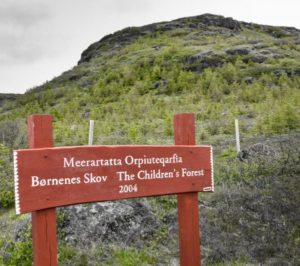
In fact, we visited a small cenca forest in the town of Igaliku , planted in 2004, with trees that have barely grown up called the Bosque de los Niños .
It was planted so that the young people could see what the trees were.
Therefore, the only way to obtain wood was to trade or wait for the currents of the sea to bring trunks from distant lands.
First Christian Church in America
Leif Ericksson , the son of Erick the Red who believed in Norse mythology, to get resources, sailed to Iceland, where he was forced to convert to Christianityand expand it if he wanted to trade.
In the time they had spent in Greenland there was a current of Christianization that had already reached the Nordic cultures
After many family discussions with Erick and his wife, he ended up agreeing to spread Christianity , which led him to build in Qassiarsuk the first Christian church in American territory.
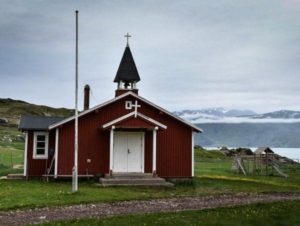
The Vikings would continue their expansion developing two more main settlements in the south, Igalicu , and Nuuk , southwest (current capital).
Currently if you want to know what are all the cities in which there were Vikingpeoples , you just have to see a map and the cities that have two names are those that had Viking culture .
In the second half of the thirteenth century, Norway claimed control over Greenland and the decline of the population began with the lack of resources.
This leads to a decline among the Viking population during the fourteenth century, until its extinction in the fifteenth century, which coincidentally coincides in time with the voyages of Christopher Columbus .
The Inuit in Greenland

The Inuit population originally came from the area of Siberia , crossed the Bering Strait and expanded from Alaska to the Arctic lands of Canada .
It is thought that there may have been some Inuit Paleo-Eskimo tribes in the west of the island, many centuries before the arrival of the Vikings , as the Inuits were nomads.
In any case, it is known that these populations disappeared and the island remained uninhabited for several centuries.
The first reliable records on his most recent arrivals date back to the early fourteenth century, when they settled permanently in Greenland.
It is a nomadic hunting community that moved its settlements based on the movements of wild animals, especially caribou, whales, seals and polar bears.
 Countries To Travel Travel Tips and Plans
Countries To Travel Travel Tips and Plans

